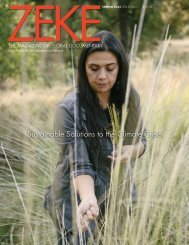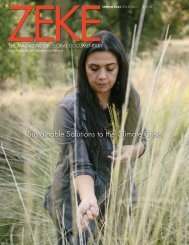ZEKE Fall 2019
Contents includes: "Youth of Belfast" by Toby Binder, and "Delta Hill Riders" by Rory Doyle, winners of ZEKE Award for Documentary Photography "Rising Tides" with photographs by Sean Gallagher, Lauren Owens Lambert, and Michael O. Snyder "Out of the Shadows: Shamed Teen Mothers of Rwanda" by Carol Allen Storey Interview with Lekgetho Makola, Head of Market Photo Workshop, South Africa, by Caterina Clerici "Why Good Pictures of Bad Things Matter" by Glenn Ruga Book Reviews and more...
Contents includes:
"Youth of Belfast" by Toby Binder, and "Delta Hill Riders" by Rory Doyle, winners of ZEKE Award for Documentary Photography
"Rising Tides" with photographs by Sean Gallagher, Lauren Owens Lambert, and Michael O. Snyder
"Out of the Shadows: Shamed Teen Mothers of Rwanda" by Carol Allen Storey
Interview with Lekgetho Makola, Head of Market Photo Workshop, South Africa, by Caterina Clerici
"Why Good Pictures of Bad Things Matter" by Glenn Ruga
Book Reviews and more...
- No tags were found...
You also want an ePaper? Increase the reach of your titles
YUMPU automatically turns print PDFs into web optimized ePapers that Google loves.
Aesthetics of DOCUM<br />
Why good pictures of bad things matter<br />
Why is it that the documentary<br />
photography community<br />
is obsessed with<br />
seeking really good photographs<br />
about really bad<br />
things that the human race<br />
brings upon each other? It is the core principal<br />
of the Social Documentary Network<br />
(SDN), <strong>ZEKE</strong> magazine and other similar<br />
organizations. While we are driven to<br />
defend victims of human rights abuses (an<br />
admirable goal), why do we place such<br />
a premium on images that present such<br />
abuse, or in some cases solutions, in a<br />
highly aestheticized manner?<br />
With SDN, we have competitions<br />
with respected jurors, all whom pour<br />
over visual stories of the human condition<br />
to select the one that is the most<br />
40 / <strong>ZEKE</strong> FALL <strong>2019</strong><br />
original, well-crafted, thoughtfully<br />
composed, and addressing something<br />
that the public deserves to know more<br />
about and possibly act on. But it is those<br />
photographs that are most aesthetically<br />
successful that win the awards.<br />
Much has been written by me and<br />
others about photographers giving voice<br />
to the voiceless, using powerful photography<br />
to inspire action, shining a light<br />
in dark places and other similar noble,<br />
if not canned, responses. Perhaps it is<br />
that artists (in this case documentary<br />
photographers) use their strengths to<br />
challenge injustices in the same way<br />
writers, poets, playwrights, and activists<br />
use the strengths they have to achieve<br />
similar outcomes. But I believe there is<br />
more to it.<br />
Photo by Maryam Ashrafi from her SDN exhibit, Mourning<br />
Kobané. A YPJ fighter looks over the wreckage left by<br />
fighting on a street in Kobané, Syria, March 2015.<br />
An Obsession with Aesthetics<br />
Why are we obsessed with aesthetics<br />
when aesthetics really has little to do<br />
with the problem or solution? Would all<br />
these resources be better spent if instead<br />
we were out on the streets demanding<br />
action?<br />
I believe the answer to our obsession<br />
with, or commitment to, aesthetics lies<br />
somewhere in the following explanations.<br />
One is that the media knows that to<br />
gain readers and viewers, they must<br />
provide interesting and complex images<br />
that only an inspired photographer can<br />
deliver. Otherwise what remains is a<br />
dense page of grey type that will neither<br />
sell content nor attract advertisers. But

















